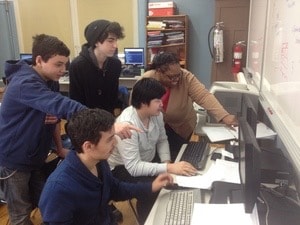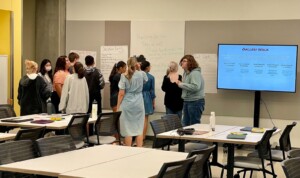It’s Time For A New Assessment System

The 28 member schools of the New York Performance Standards Consortium share a performance assessment system. It was approved as an alternative to state tests by the Board of Regents in 1995 and reaffirmed in 2008 when additional schools were added.
Networks schools share:
- Practitioner-designed and student-focused assessment tasks
- External evaluators for written and oral student work
- Moderation studies to establish reliability
- Extensive professional development
- Predictive validity based on graduates’ college success
- Inquiry-based teaching and learning
Schools joined the consortium to benefit from the performance assessment system and to avoid state Regents exams. Graduation and college acceptance rates are better than city wide averaged but some observers suggest that execution across the network is uneven.
Developed 20 years ago, the Consortium doesn’t share all the new forms of digital formative assessment that many schools benefit from today. But the Consortium serves as an important example of a school network granted an assessment waiver. Member schools have been able to focus on assessments aligned with their instructional program.
A report by the New York Civil Liberties Union said:
The Consortium has been able to thrive in New York because the state provided it with time and a “safe space” to innovate, develop, and refine its system. Over the past dozen years, while we have witnessed the serious shortcomings of large-scale assessment systems imposed on teachers and classrooms “from above,” the Consortium system—teacher-designed and flourishing at the school and local levels—has nurtured a committed cadre of practitioners who believe in the system and have devoted years of work to grow it and refine it.
Backstory. Ann Cook founded Urban Academy (featured image) in 1986 with a focus on inquiry teaching where teachers “frame questions in a way which challenges students to examine often conflicting evidence, draw conclusions and support these conclusions in thoughtful discussions with others who, using the same evidence base, reach divergent conclusions.”
Urban Academy shares the Julia Richman Education Complex with five other schools. It’s the first and perhaps best example of replacing a failing high school with new collocated schools. Each of the schools engage students and valued authentic work. They are all unique but collaborate to make JREC a positive place for kids.
In addition to making JREC work, Ann Cook was the driving force behind the Consortium, an advocacy strategy to protect and scale the work Urban Academy started.
JREC inspired the small learning communities movement which lead to big improvements in graduation rates in cities Kansas City Kansa (discussed here). JREC illustrated the viability of collocation which benefited the growth of school networks including NAF and New Tech Network.
Time for innovation. There are three reasons that it’s time for innovation in assessment:
- With the shift to digital learning (#ShiftToDigital) many learning experiences come with embedded and aligned formative assessment. As a result, students and teachers are benefiting from a significant increase in the amount of feedback creating a new opportunity to create robust shared systems of assessments.
- Many parents and teachers that object to week long end of year tests already know how kids are doing. Their pushback creates an opportunity to pilot better use of formative assessment.
- With the reauthorization of federal education policy states have more latitude to determine standards and assessments.
For these reasons, the Assessment for Learning Project was formed by the National Center for Innovation in Education and Next Generation Learning Challenges. About a dozen grants will be awarded this month and will signal the path forward.
Pilots & zones. The only similar project to the Consortium is New Hampshire’s Performance Assessment of Competency Education (PACE), the first federally approved accountability system that offers a reduced level of standardized testing together with locally developed common performance assessments designed to support deeper learning through competency education.
Last year four PACE implementing districts gave the Smarter Balanced assessment once in elementary school, once in middle school and once in high school, in three grades instead of seven. The state is also conducting a readiness survey to identify the next eight districts to include in the pilot. In the spring PACE districts will administer common and local performance assessments developed by the districts. For comparability, Smarter Balanced Achievement Level Descriptors are the basis for establishing cut scores. Regional calibration scoring sessions will be conducted to build inter-rater reliability and consistency in scoring across districts.
It’s likely that the regulations that will accompany recently reauthorized federal education legislation will include room for innovation pilots like PACE.
The other alternative path forward is the use of innovation zones where systems earn the right to opt out of testing by demonstrating that their proposed alternative assessment system can report comparable results. Districts, networks, and consortia could apply to become a ‘certified assessment system’ after demonstrating their ability to report comparable learning levels and growth rates.
This innovation zone strategy could be implemented by an a statewide authorizer using performance contracting to engage districts and networks in experiments with new delivery strategies, talent development structures, and measurement systems. With a combination of pressure and incentives over five to 10 years, an innovation zone could become the primary delivery and accountability system for the state.
In summary, assessment pilots would run parallel systems to demonstrate comparability in action while innovation zones would require demonstrated comparability before receiving a waiver.
Susan Patrick, iNACOL, said, “States desperately need the flexibility to be able to do this to innovate.” After a few dozen districts in a handful of states demonstrate new lightweight testing systems the rest of the states are likely to follow suit.
For more see:





0 Comments
Leave a Comment
Your email address will not be published. All fields are required.